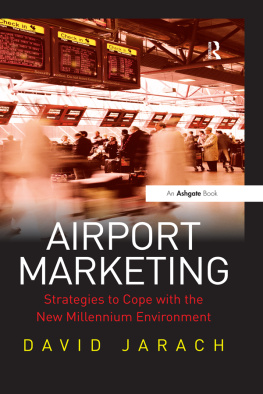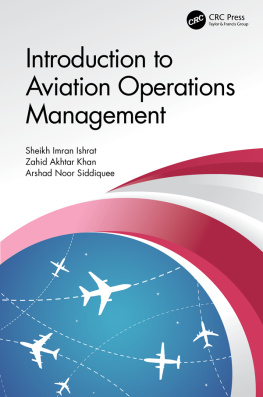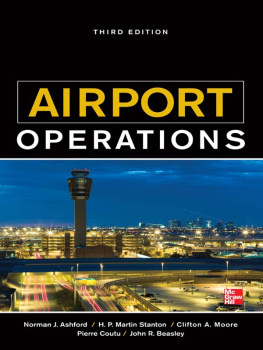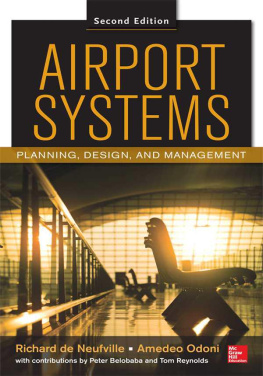First published 2005 by Ashgate Publishing
Published 2016 by Taylor & Francis
2 Park Square, Milton Park, Abingdon, Oxon OX14 4RN
711 Third Avenue, New York, NY 10017, USA
Routledge is an imprint of the Taylor & Francis Group, an informa business
Copyright 2005 David Jarach
David Jarach has asserted his right under the Copyright, Designs and Patents Act, 1988, to be identified as the author of this work.
All rights reserved. No part of this book may be reprinted or reproduced or utilised in any form or by any electronic, mechanical, or other means, now known or hereafter invented, including photocopying and recording, or in any information storage or retrieval system, without permission in writing from the publishers.
Notice:
Product or corporate names may be trademarks or registered trademarks, and are used only for identification and explanation without intent to infringe.
British Library Cataloguing in Publication Data
Jarach, David
Airport marketing : strategies to cope with the new
millennium environment
1.Airports - Marketing 2.Airports - Economic aspects
I. Title
387.73640688
Library of Congress Cataloging-in-Publication Data
Jarach, David.
Airport marketing : strategies to cope with the new millennium environment / by
David Jarach.
p. cm.
Includes bibliographical references and index.
ISBN 978-0-7546-4085-1 (hbk)
1. Airports--Economic aspects. 2. Airports--Management. 3. Aeronautics,
Commercial--Economic aspects. I. Title.
HE9797.4.E3J37 2005
387.7,360688--dc22
2005011793
ISBN 9780754640851 (hbk)

Royal/Dutch Shell is one of the worlds premier oil companies, with a history dating back to when the same oil industry was bom. Shell was market leader for many years in the UK, one of its home markets. However, in a relatively short amount of time, Shells comfort zone was successfully attacked and taken over by an innovative value proposition. As such, Shells top managers realised that a supermarket chain, Tesco, had become the largest petrol retailer in Britain.
Similarly, we may think of current trends in the banking business. Monopolistic or oligopolistic rents have been destroyed firstly by national deregulation; and then, traditional banking propositions have been hit by a technological quantum leap driven by the upsurge of on-line banks. Customers have already experienced some consequences of this evolved market scenario: an increased range of value-driven competition, a continuous development of new marketing tools to attract and retain customers and, eventually, some consolidation practices between players to get economies of costs from both internal and external processes.
In a broader sense, the continued disruption of once stable arenas permits unexpected competitors to emerge thanks to technological changes, globalisation and deregulation patterns, the constitution of new clusters of demanding customers rather than the availability of parallel, unlocked distribution channels. Firms with little respect for industry conventions are thus able to overcome the existing boundaries, establish new patterns of interactions and eventually experiment with sound economic returns even in sufficiently difficult times.
Hyper competition, turbo competition or simply unexpected competition, due to convergence of apparently separate and discordant industries to form meta-markets, therefore puts managers in a position to look for a radical shift in their strategic market approach.
First of all, they must have a deep understanding of both the magnitude and the diversity of the various forms of competition by using advanced tools and methodologies to avoid marginalisation in their own core business. In other words, they have to improve their in-depth knowledge about the enlarged ecologic system in which their company lives.
Second, managers have to keep in mind that innovation in business concepts and designs is much more than a simple imperative, if their companies want to maintain a positioning at the forefront of the profit continuum and, thus, get extra revenues and yields from the market. The goal of business concept innovation is to introduce more strategic variety into an industry or competitive domain. When this happens, and when customers value positively this proposition, the distribution of wealth-creating potential may dramatically shift in favour of the innovator.
Turning our attention to airport practices, evidence clearly shows that value has increasingly migrated away from traditional business designs tailored to serve airlines needs towards new business designs that better match the shifting priorities both of current and of new clusters of end customers.
Thus, airports whose aims are to reach a status of best-in-class operators must generate new incremental commercial experiences that reinforce their power of attraction to both passenger and cargo businesses. Airports must also project enlarged value designs to capture, in a new platform of consumption, airports neighbouring residents, meeters and greeters, airport employees, air transport employees and, eventually, companies located within the airports catchment area.
This market-based rather than innovative quantum leap approach is being implemented by a new category of airports entering the market arena: the so-called commercial airports. These players strive to perform an extreme diversification of non-aviation related activities within its own boundaries, instead that conserving a sole and conservative focus on aviation-related services. This shift is not simply a consequence of a narcissistic will to improve airports appeal, but a current economic need to fight the downward spiral that is cutting margins on former traditional sources of monopolistic rent for airport authorities. Thus, in a short amount of time, airports that have not undergone a transition from old to this new value design will be almost certainly marginalised and can only survive in a subsidised environment.
This book aims first to explore the existing boundaries of the airport industry within the air transport value chain. The basic economics of the airport business will be examined and a correlation analysis of B2B and B2C relationships within the air transport value chain will take place.
Furthermore, the two main strategic business units (SBUs) of modem airport enterprises, the aviation-related and the non-aviation related ones, will be explored by using a new line of research and a creative paradigm of analysis. The use of a significant number of microcases will support the analysis as appropriate. Following the presentation of some new ideas, like the launch of Airport Loyalty Programs, a description of the main steps of an airport marketing plan will also be provided.
The final part of the book will be dealing with security issues that the industry is facing within the post-September 11 scenario. Some of the answers that international ruling bodies are now trying to put in practice to reduce the terrorist threat will be described and analysed. These pages have been written together with Mr. Alfredo Roma, a former chairman of ENAC (The Italian Civil Aviation Authority) and current ECAC (European Civil Aviation Conference) president and, due to this double role, certainly one of most involved people in exploring security solutions for the industry since the early moments after the Twin Towers attack.
After a presentation of some data on the airport business in 2002, 2003 and 2004, this book, finally, hosts a postface signed by Mr. Jean Cyril Spinetta, Chairman of Air France. These pages are aimed at showing the perspective of a mega carrier on the evolution of the market relationship with airports in the New Millennium environment.










